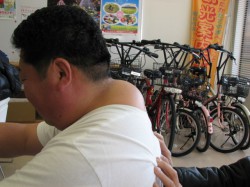No one has a sure count of all of Tateyama’s matsuri festivals, but they number roughly 100. Not a week goes by, from late March through October, without at least one festival somewhere in Tateyama.
Takahashi Takeshi, native Tokyo-ite and now Tateyama transplant, has been trying to catalog them. “I came here as an outsider, and one of the first things I noticed was how many matsuri there are. I kept asking why, but no one seems ever to have thought about it or even to have realized there were so many.”
Diverse, abundant, fresh, intensely local: these describe Tateyama culture as they do its fish and flora. Every coastal cove and fold in the hills has its own little microclimate, and the settlement housed in each evolved in its own social ecosystem.
Each time you come back to Tateyama, therefore, you’ll find both the familiar and something entirely new and distinctive.
The Toyofusa lion dance in July to pray for rain, when boys put on lion’s heads crowned with feathers, and girls, in headdresses of many-colored streamers, cry like frogs to the beat of the boys’ drums…
The Mona hamlet’s Taro Festival in February when the handful of households offer Maoming potatoes at their hilltop shrine with dances and rites for which there is no written record, and then ceremoniously divide them among the villagers to store against winter hunger…
The mid-summer downtown extravaganzas of lantern-lit lacquered floats and wildly swerving portable shrines…
And, out on the very tip of the peninsula, with distant Mt. Fuji framed perfectly in the Sunosakitorii gate, three days in August when young men shoulder and sway a golden shrine down 148 steep steps; priests throw offerings of sacred sake directly into the ocean; and these rituals complete, the entire community gives itself up to unabashed fun…
The city and prefecture designate these, and many others, “intangible folk cultural properties.” But it is up to the communities themselves to plan them, to pay for them, and to preserve them.
Today, they still do. “Where there are a lot of matsuri, bad things don’t happen,” says Mr. Takahashi.
